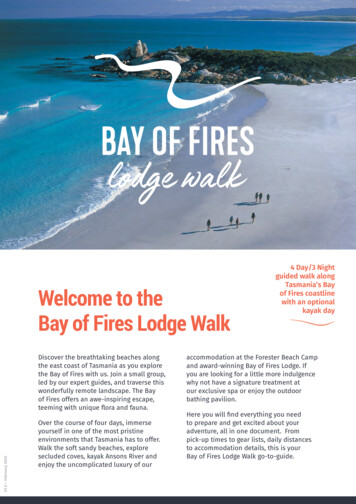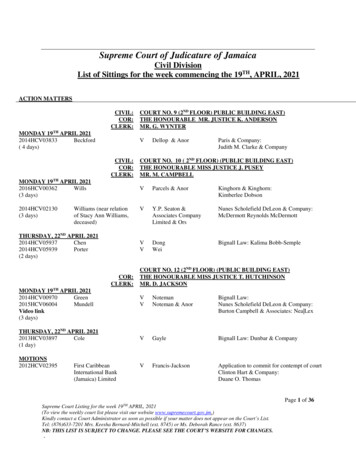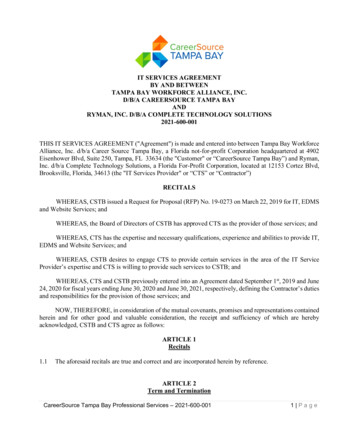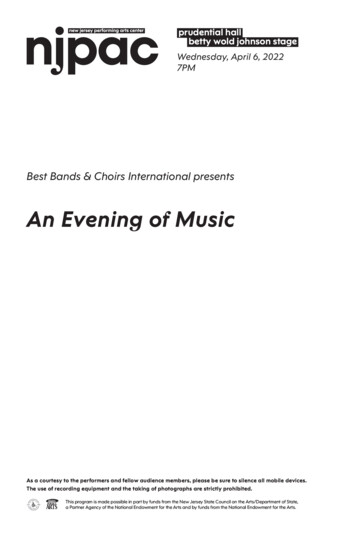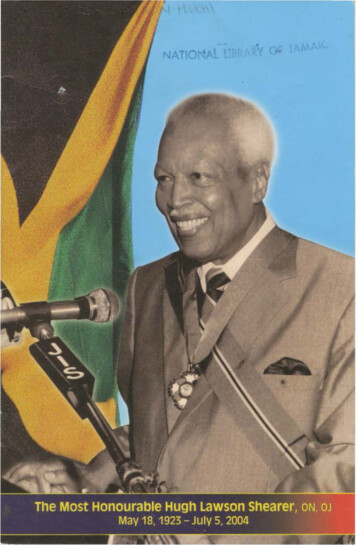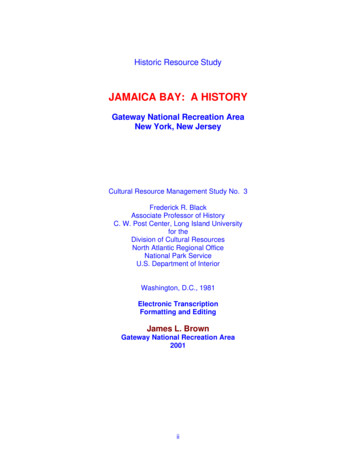
Transcription
Historic Resource StudyJAMAICA BAY: A HISTORYGateway National Recreation AreaNew York, New JerseyCultural Resource Management Study No. 3Frederick R. BlackAssociate Professor of HistoryC. W. Post Center, Long Island Universityfor theDivision of Cultural ResourcesNorth Atlantic Regional OfficeNational Park ServiceU.S. Department of InteriorWashington, D.C., 1981Electronic TranscriptionFormatting and EditingJames L. BrownGateway National Recreation Area2001ii
FORWARDCultural Resources and Natural AreasJamaica Bay is a place well known for its flora and fauna. This study adds another dimension to JamaicaBay - -its use by humans, especially during the Historic period. Understanding the human use of the Bayand its shore is both timely and historically interesting. Historically it is often entertaining, as well asInformative, to learn how our ancestors, and the Native Americans who lived here before them, madetheir livings in an environment that is at once the same and different from the one we know - - the same inthat much of the geography is similar; different in that the recent past has witnessed massive alterationsto the natural environment of the Bay.This study helps place the substantial modern changes in perspective. In doing that, it is timely.Increasingly we are made aware of the relatedness of cultural and natural phenomena. Jamaica Bay isno more a strictly natural resource than Manhattan Island. The history of human land use is an essentialguide to comprehending the Bay’s natural environment currently and in the near future.The goals of Dr. Black’s research were primarily managerial. We sought sufficient information to evaluatecultural resources, that is, historic and prehistoric archeological sites and historic structures within theJamaica Bay Unit of Gateway National Recreation Area. Happily, the study provides much more than afine management aid. It has a large potential to inform interested persons about the area and assist theGateway staff in interpreting it. For these reasons the Park Service has funded the printing anddistribution of the study.Francis P. McManamonChief, Division of Cultural Resources2 March 1981iii
TABLE OF CONTENTSINTRODUCTION: Scope, Problems, Methods, Sources.1I. JAMAICA BAY, 1600-1865.4Early Seventeenth-Century Indian Life .4Flatlands .9Bergen and Mill Islands. 11Barren Island . 14Flatbush, New Lots and Jamaica. 17Agriculture . 19Jamaica Bay Fisheries . 21Shipping. 22II JAMAICA BAY AFTER 1865: ISLANDS, LANDINGS, AND MAINLAND. 25Barren Island . 25Canarsie . 43New Lots. 48Howard and Hamilton Beaches . 51The Islands . 56III JAMAICA BAY AFTER 1865:FISHING, SHIPPING, TRANSPORTATION,TOPOGRAPHICAL CHANGE . 61Fishing . 61Shipping. 65Transportation . 68Topographical Changes . 71CONCLUSIONS AND RECOMMENDATIONS. 80FOOTNOTES. 83Chapter I. Jamaica Bay, 1600-1865 . 83Chapter II. Jamaica Bay After 1865: Islands, Landings, and Mainland . 87Chapter III. Jamaica Bay After 1865: Fishing, Transportation, Topographical Change . 91ANNOTATED BIBLIOGRAPHY. 95I. Published Historical Sources . 95II. Census Reports . 96III. Town and Municipal Records and Reports . 96IV. New York State Reports and Publications . 97V. Cartographic Sources . 98VI. Newspapers . 99VII. Secondary. 99VIII. Directories. 102IX. Miscellaneous . 103iv
LISTS OF FIGURES and TABLESFigure 1 Jamaica Bay: General Reference .3Figure 2 Indian Sites.5Figure 3 Flatlands and New Lots, 1700 . 13Figure 4 Barren Island, 1850-1911 . 16Figure 5 Flatlands and New Lots, 1873 . 28Figure 6 Barren Island and Flatlands Bay, 1911 . 34Figure 7 Barren Island and Flatlands Bay, 1926 . 35Figure 8 Barren Island and Flatlands Bay, 1940 . 36Figure 9 Mill Island and Bergen Island, 1911. 40Figure 10 Mill Basin and Bergen Beach, 1926. 41Figure 11 Mill Basin and Bergen Beach, 1940. 42Figure 12 Canarsie Shoreline, 1911-1940 . 46Figure 13 North Shore, 1911. 53Figure 14 North Shore, 1926. 54Figure 15 North Shore, 1940. 55Figure 16 Central Islands, 1911. 76Figure 17 Central Islands, 1926. 77Figure 18 Central Islands, 1940. 78Figure 19 Central Islands, 1977. 79Table 1Table 2Table 3Table 4Table 5Flatlands Agriculture 1865 and 1875 . 20Barren Island Industries. 29Flatlands Occupations: Agriculturists And Bay Related Workers. 62Powered Oyster Boats Five Tons or Over Active in Jamaica Bay . 63Ferry Service, Jamaica Bay . 66v
INTRODUCTION: Scope, Problems, Methods, SourcesThis history covers that portion of Jamaica Bay within the confines of the Jamaica Bay Unit of theGateway National Recreation Area. That unit includes essentially the shore front east and south of theBelt or Shore Parkway from Plum Beach to Spring Creek Park, the waters of the bay itself, and theislands and marshes therein. Not within the Jamaica Bay Unit are the communities of Broad Channel,nearly all of the mainland on the Queens side of the bay, or any part of Rockaway peninsula.Chronologically, the study begins with the arrival of the Dutch in the seventeenth century and ends withthe middle of the twentieth century. Topically, the focus falls on the historic “uses” of the bay and itsperiphery. Generally, those uses consist of residential settlement; agriculture, industry, fishing, shipping,other forms of transportation, and recreation. Some of these activities required alteration in thetopography of the bay, and a description of the major alterations is contained in this study.Although the foregoing paragraph defines the broad perimeters of this history, they have not been rigidlyobserved. A number of considerations has dictated departures from strict boundaries in time, space andtopic. For example, more than likely, before the early nineteenth century, no one actual resided in anypart of the area now within the Jamaica Bay Unit. And yet during that time, inhabitants of the largervicinity used the bay. To understand that usage requires investigation into the communities within thevicinity. On the other hand, certain activities clearly within the formal boundaries of the Jamaica Bay Unitare poorly covered in the surviving record. For almost three hundred years, Jamaica Bay constituted afisherman’s paradise. Yet little can be determined about fishing in the bay prior to the middle of thenineteenth century.Other topics have been adequately covered in the existing secondary works, including those produced forthe National Park Service. The history of Floyd Bennett Field is well enough known, yet for a longer timethan that field was an active airport, there had existed almost in the same area a strange industrialcomplex, the Barren Island fish oil and fertilizer factories about which little has been written. Thus logic,the availability of sources the existing secondary literature, and the preferences and competence of thewriter have occasioned flexibility in the scope of the present study.Some of the problems encountered in the preparation of this history have been already hinted at, such asthe failure of early sources to comment at length about commonplace matters. For example, what kinds ofboats eighteenth-century fishermen used is far from clear. Reflections upon the inadequacies of sourcesis doubtless all too common among historians. However Jamaica Bay presents special problems.Primary is the wide dispersal of the record of the bay. Until the twentieth century, few regarded JamaicaBay as a whole unit. Politically, its waters and adjacent lands fell with numerous jurisdictions—the townsof Gravesend, Flatlands, Flatbush, New Lots, Jamaica and Hempstead; the counties of Kings andQueens; and later the municipalities of Brooklyn and of Greater New York. This means that extantrecords are scattered among numerous depositories. Some apparently have been lost, such as thepapers of the Canarsie Chamber of Commerce.
Methodologically, this history is conventional, and the chief effort has been to piece together informationfrom primary sources where possible and from secondary authorities where need be so as to achieve anunderstanding of Jamaica Bay’s past. Some simple quantification analyses have been employedrequiring no prefatory elaboration.Among the more rewarding primary sources used in this study are nineteenth-century federal and statecensuses for the Town of Flatlands. Beginning with the year 1850, those reports list occupations and thusprovide important information about economic activities in the vicinity of the bay. The records of the towngovernment of Flatlands have also been explored. Especially the annual assessment rolls provedinvaluable in identifying the companies engaged in manufacturing at Barren Island. When Flatlandsceased existence as an independent town and joined Greater New York, its common lands, includingmost of the marshlands along the western side of the bay, became the property of New York City,administered for over three decades by the Department of Docks and Ferries. The annual reports of thatdepartment are infuriatingly general with respect to many matters, but the rent rolls they contain list allleases of land under water and of other sites in Jamaica Bay. Such lists are an index to use of the bay forpurposes of vacation-type buildings. A variety of maps have been consulted. Most accurate and usefulare the maps of the United States Coast and Geodetic Survey, now known as the National Oceanic andAtmospheric Administration. Comparison of the Jamaica Bay charts for the years 1878, 1911, 1926,1940, and 1977 provides a means of tracing the changes in the bay’s topography. In the bibliography ofthis study, particular sources will receive further comment.2
Figure 1 Jamaica Bay: General ReferenceSOURCE: Park Association, NYC, Jamaica Bay, (1968)3
I. JAMAICA BAY, 1600-1865The waters of Jamaica Bay did not serve as an avenue for settlement of the southwestern segment ofLong Island. European settlers arrived in the seventeenth and eighteenth centuries by way of landroutes. Those settlers were not the first human inhabitants of the area, since several important villages ofthe Canarsie Indians were in the general vicinity of the bay. From 1624 to 1664, western Long Island,Manhattan and other parts of the Hudson Valley were included in the province of New Netherlands,administered by the Dutch West India Company.Settlement or other permanent use of Long Island was delayed until 1636, when the Dutch began activityin what became Kings County. They negotiated for land and started settlements at Amesfort or Flatlandsand at Gowanus Bay. Soon the Dutch West India Company secured from the Indians title to virtually allof the land in Kings County.Conquest of New Netherlands by the English in 1664 was followed by a smooth transition of LongIsland’s Dutch inhabitants into their new status as subjects of the crown of England. A century later,American colonists embarked on a movement that climaxed in independence from England. During theRevolutionary War, towns in the vicinity of Jamaica Bay, along with the rest of western Long Island, hadan experience different from others in America since following their victory in the battle of Brooklyn in1776; British Forces established an occupation that persisted until 1783 and the end of the war.Early Seventeenth-Century Indian LifeHistorical and archaeological literature refers to numerous Indian sites in the Jamaica Bay vicinity.According to 1934 work by Reginald Bolton thirteen sites existed within two or three miles of the bay.Those in what became Kings County were Narriock(Sheepshead Bay), Massabarkem (Gravesend),Ryders Pond(Gerritsen Creek), Keskaechqueren (Flatlands), Winnipague (Bergen Beach), Canarsie, andMuskyttehool, on the upper reaches of Bedford Creek. The Queens County sites consisted of Jamaica,Aqueduct, and locations on Hawtree, Bergen, Cornell, and Hassock Creek 1 Several entries on Bolton’slist, such as Muskyttehool and Massabarkem, are merely places assigned Indian names in historicaldocuments and suspected of having importance in Indian activities.Subsequent scholarship tends to limit sites to places known to have contained artifacts, namely RydersPond, Bergen Beach and Aqueduct. 2 All of the sites, both historic and archaeological, have beendestroyed by filling and construction, and, prior to that destruction, none was the location of professionalarchaeological field work.1 Reginald Pelham Bolton, Indian Life Long Ago in the City of New York (Port Washington, N.Y.:Ira J. Friedman, 1971; originally published 1934), 144-51.2 Carlyle Shreeve Smith, The Archaeology of Coastal New York (vol. 45, part 2, AnthropologicalPapers of the Museum of Natural History (New York: American Museum of Natural History, 1950); LynnCeci, "The Effect of European Contact and Trade on the Settlement Patterns of Indians in Coastal NewYork, 1524-1665: The Archaeological and Documentary Evidence," diss. City University of New York,1977.4
Figure 2 Indian SitesSOURCE: Bolton, Indian Life, pp. 144 . 515
The best information comes from a collection of Ryders Pond artifacts, originally assembled in the late1890s without field notes or stratigraphic data and systematically analyzed in 1961.3Generally speaking, specific archaeological information about aboriginal cultures at Jamaica Bay duringthe early historic period is slim. Documentary evidence, although frequently lacking in particulars andoften uncertain respecting exact locations, provides some insights. Moreover, on the basis of findings forarchaeological sites elsewhere in coastal New York, scholars have produced a model of Indian culture atthe time of contact. The cultural pattern of Indians of western Long Island at the end of the sixteenthcentury is classified by archaeologists as Late Woodland, East River Aspect, Clasons Point Phase.Important elements in that cultural pattern include permanent settlements, occupying approximately oneacre and located on tidal streams and bays. Profuse remains of marine shellfish and smaller amounts ofmammal, bird, amphibian, and fish bones indicate an economy emphasizing fishing and hunting. Fishwere captured by nets weighted with stones and by single-piece barbless bone hooks. Shellfishingequipment consisted of dug-out canoes and wooden rakes.4Recently Lynn Ceci has questioned the role of maize cultivation among late pre-contact coastal peoples.Others admit that the evidence for such cultivation is slight, but nevertheless conclude the practice waswell established. Clasons Point artifacts include stone hoes, stone pestles, shallow mortars, and woodengrinding gears, all of which suggest the raising of corn. Ceci’s claim is that the production of maizebecame extensive after and as a result of contact with Europeans.5No indications have been discovered that native peoples in the vicinity of Jamaica Bay did not conform tothe general culture associated with Clasons Point. Those people, along with others of coastal New York,spoke Algonkian languages. Politically, they were part of the Metoac confederacy, a loose affiliation ofthe thirteen ethnic groups on Long Island. Among the western Metoac were two closely related groups,the Canarsie and the Rockaway. Lands of the Canarsie included all of modern Kings County and part ofthe town of Jamaica. The bulk of Queens County, including the remainder of Jamaica, and the southernpart of the town of Hempstead were occupied by the Rockaway.6 Thus, the western and northern shoresof Jamaica Bay fell within the territory of the Canarsie, and the eastern belonged to the Rockaway.The Canarsie had four important sites near the bay. Earlier authorities and those relying on them assertthat the main village of the Canarsie was located in the Canarsie section of the Dutch town originallyknown as Amesfort and later as Flatlands. Archaeologically, the site is said to have been conspicuousbecause of “immense shell heaps.” Bolton describes Canarsie as “a village site,” with “extensive plantingfields, extended back from Canarsie Beach Park as far as Avenue J, centered on East 92nd Street.”7Documentary evidence substantiates the existence at Canarsie of Indian maize fields.Another Canarsie site was Winnipague, later known as Bergen Island or Bergen Beach. Bolton, who3. Julius Lopez and Stanley Wisniewski, "The Ryders Pond Site, Kings County, New York," TheCoastal Archaeological Reader: Selections from the New York State Archaeological Bulletin, 1954-1977:Readings in Long Island Archaeology and Ethnic History, vol. II (Stony Brook, N.Y.: Suffolk CountyArcheological Association, 1978), 206-27, 233-47.4 William A. Ritchie, The Archaeology of New York State (Garden City, N.Y.: The NaturalHistory Press, 1965), 269-71; Smith, 101, 158.5 William A. Ritchie and Robert F. Funk, Aboriginal Settlement Patterns in the Northeast (Memoir20, New York State Museum and Science Service; Albany: University of the State of New York, 1973),178; Ritchie, 270; Ceci, 1-3, 191.6. Allen W. Trelease, Indian Affairs in Colonial New York (Port Washington, N.Y.: Ira J.Friedman, 1977; originally published 1960), 7-9.7 F. M. Ruttenber, History of the Indian Tribes of Hudson's River (Port Washington, N.Y.: Ira J.Friedman, 1971; originally published 1872), 73; William Wallace Tooker, The Indian Place-Names of LongIsland and Islands Adjacent (Port Washington, N.Y.: Ira J. Friedman, 1962; originally published 1911),31-33; John O’Halloran, "Canarsie Indian Sites," Long Island Forum, vol. XIII, number 4 (April 1950), 6364, 66, 75; Arthur C. Parker, The Archeological History of New York (Albany: University of the State ofNew York, 1920), 582; Bolton, 148.6
categorizes the site as an “important station,” writes of “the extensive shell beds on this island, and stoneimplements.” In 1949, another writer actually retrieved prepared conch whorls and a broken arrowhead atBergen Beach. What kind of activity Indians engaged in at Winnipague is by no means clear, oneconjecture being that the island was a large wampum-making center.8Unlike the Canarsie and Winnipague sites, Ryders Pond produced a substantial quantity of artifacturalspecimens. Those specimens are attributed to the Clasons Point focus, East River aspect. The site waslocated on Strome Kill, subsequently known as Gerritsen Creek or Gerritsen Basin, and later fell withinthe confines of Avenue R, East 32nd Street, Avenue W, and Stuart Street. Today the site is part ofBrooklyn Marine Park. Bolton designates the village as Shanscomacoke, a name used in the Indianconveyance of Equendito or Barren Island in 1664.9In 1939, the Flushing Historical Society investigated the Aqueduct site, near the head of Hawtree Creek.Shortly thereafter, the location was buried by construction of the Shore Parkway. The chief findings wereseveral bowl-shaped pits containing refuse and one burial pit. Pottery artifacts discovered belong to theEast River tradition. Bolton states: "A site of native occupancy was found at Aqueduct Station. . . . Manyfragments of pottery indicated that the clay which existed in the vicinity was utilized to make pottery."10Canarsie, Bergen Beach, Ryders Pond, and Aqueduct were probably the only sites of significant activityor habitation by the Canarsie Indians within close proximity of Jamaica Bay. Other sites listed by Boltonseem to have produced no verifiable artifactual specimens and enter the historical record because ofmention in conveyances from the Indians to Europeans.Between 1636 and 1667, the Indian title to practically all land in Kings and Queens counties, including theshores of Jamaica Bay, was terminated. In three separate deeds, all dated June 16, 1636; CanarsieIndians assigned to the Butch a tract called Keskateuw. That tract encompassed almost the entirety ofthe western side of the bay and came to constitute the land of the Dutch town of Amesfort.11Canarsie Indians remained in the area, however, not regarding the land transactions as extinguishing allof their rights. Nevertheless, their numbers declined, Native occupancy at Jamaica Bay may havepersisted longest in the Canarsie section of Amesfort. Dutch residents in the village of Amesfort rentedIndian fields at Canarsie until the mid-1660s.Then the lands at Canarsie were sold outright to the Dutch, with the condition:.that the purchasers once for always a fence shall set at Canarissen for the protection ofthe Indian cultivation., and the land which becomes inclosed in fence shall by the Indianowners above mentioned all their lives to be used, to wit, by Wametappack, the Sachem,with his two brothers. 128 Bolton, 146; O'Halloran, 63; Frederick Van Wyck, Keshachague or the First White Settlementon Long Island (New York: G. P. Putnams Sons 1924) 108.9 Lopez and Wisniewski, 209; Bolton, 146; Indian Deed, May 13, 1664, to John Tilton andSamuel Spicer, in Abstract of the Title of the Southern part of Barren Island. . . . (unpublished typescript,no date), Long Island Room, Queensborough Public Library (hereafter cited as QPL).10Smith, 170-71; Bolton, 151.11Indian Deed for Land on Long Island, Called Sewanhacky (for the middle "flat"); Indian Deedfor Land on Long Island (western "flat"); Indian Deed for Land on Long Island (eastern "flat"), in EdmundB. O'Callaghan (ed.), Documents Relating to the Colonial History of the State of New York (15 vols.,AIbany: Weed, Parsons and Company, 1856-87), vol. XIV, 2-412 Indian Deed, April 23, 1665, quoted in Anson DuBois, "History of the Town of Flatlands," inHenry R. Stiles (ed.), The Civil, Political, Professional and Ecclesiastical History and Commercial andIndustrial Record of the County of Kings and City of Brooklyn, N. Y. from 1683 to 1884 (3 vols., New York:W. W. Munsell & Co., 1884),vol. I, 71.7
That only three Indian families remained suggests that by the 1660s Native Americans were nolonger a significant part of activity at Jamaica Bay. According to the model of late Woodlandculture prevalent in western long Island, Canarsie and Rockaway Indians living adjacent toJamaica Bay practiced an economy that doubtless involved exploitation of the bay and its shores.Planting fields existed at Canarsie and perhaps at Bergen Island. The model as well as reports oflarge shell deposits point to the importance of shellfishing. Ryders Pond contained remnants ofhard clam, soft clam, oysters, scallops, whelk, and periwinkle.13 Shellfish may have beengathered by hand, but canoes were also employed.Two historical accounts provide information about Indian canoes in the general region of Jamaica Bay. In1679, two visitors from the Netherlands went to Najack, now Fort Hamilton, where seven or eight Indianfamilies lingered on. Included in the journal of the visitors is an account of Najack methods of fishing:For fishing, a canoe without mast or sail, and without a nail in any part of it, though it issometimes full forty feet in length, fishhooks and lines, and scoops to paddle with in placeof oars.14Najack Indians were a sub-unit of the Canarsie, and there is no reason to suspect that such canoes werenot also in use at Jamaica Bay. An earlier account describes a 1643 diplomatic mission by DavidDeVries from Manhattan to Long Island to meet with Indian chiefs. That meeting took place at “RechquaAkie,” described as being seven miles from Manhattan and “on the seacoast.” Of the return trip, DeVrieswrites:We went to the canoes for the purpose of going, and to make the journey shorter than wecame. . . . When we reached the canoes, we found that the tide had not yet begun tomake and that we must wait some time before it would be flood. . . . Finally, twenty of uswent in a canoe or hollow tree, which is their boat, and the edge was not more than ahand’s breadth above the water.“Rechqua Akie” is believed to be a version of “Rockaway,” and the name of the main village of theRockaway Indians, located near today’s East Rockaway.15 Again we find use of large dug-out canoesby Indians of western Long Island. Moreover, on this occasion they were employed for transportationpurposes including passage from the south shore to Manhattan.Whether from canoe or otherwise, shell fishing served two purposes during the contact period, being asource of food and also providing material for the production of wampum beads. Wampum makingamong New York coastal Indians developed after the arrival of white traders and settlers. Ritchie states:“It seems clear that, properly speaking, wampum was a European trade-inspired commo
of Gravesend, Flatlands, Flatbush, New Lots, Jamaica and Hempstead; the counties of Kings and Queens; and later the municipalities of Brooklyn and of Greater New York. This means that extant records are scattered among numerous depositories. Some apparently have been lost, such as the papers of the Canarsie Chamber of Commerce.


